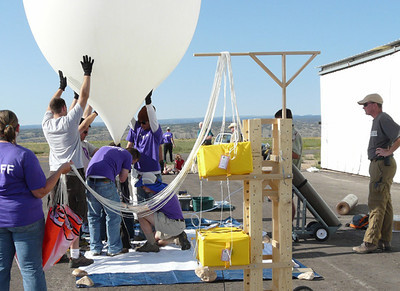Air Pollution Weather Balloon
 Three Weber State University electronics engineering students accepted the real-world
Three Weber State University electronics engineering students accepted the real-worldchallenge of reliably and economically measuring pollution zones above Utah's metropolitan areas. They spent
more than 1,000 hours researching and developing a robust, yet inexpensive, device that could help the scientific
community better understand urban inversions and even global climate change.
Seniors Michael Petersen, Wesley Mahurin and Jenifer Stoddard presented their project at WSU's 10th Annual
Undergraduate Research Symposium and Celebration March 31 in the Shepherd Union Building. They were
among 150 of WSU's undergraduate researchers who shared their research findings and experiences with the
campus and community. The symposium represents a broad cross section of departments and disciplines,
including science, health professions, social sciences, humanities and the arts.
The public was invited to attend the symposium, scheduled from 10 a.m. to 5 p.m. Oral presentations ran from 10
a.m. to 11:30 p.m. and 1:30 to 3 p.m. in Shepherd Union Ballroom C and rooms 312 and 316. Poster
presentations were slated from 3 to 4 p.m. in the Shepherd Union Atrium. A complete schedule is available at
weber.edu/OUR.
Petersen, an aerospace enthusiast, has been a member of WSU's High Altitude Reconnaissance Balloon for
Outreach and Research (HARBOR) program for three years. HARBOR employs a latex, helium-filled atmospheric
weather balloon that travels to the edge of outer space, gathering scientific measurements from Earth's
atmosphere, such as air pressure and temperature, along the way. Since its maiden voyage in 2008, it has been
launched 26 times, with the highest flight reaching 110,718 feet above sea level.
"HARBOR flights routinely reach altitudes well above 80,000 feet. This puts WSU student-built instrument
payloads above 99 percent of Earth's atmosphere -- quite literally at the edge of space," said John Sohl, HARBOR
program director and WSU physics professor.
Balloon systems are valuable tools for understanding Earth's climate and weather systems at altitudes not
attainable by aircraft (which fly too low) and spacecraft (which orbit too high). At mid-range altitudes, there is a
shortage -- and need of -- data for gas compositions and pollution levels.
Organizations such as the National Oceanic and Atmospheric Administration (NOAA) take regular daily
measurements of atmospheric wind speed and direction. They don't, however, measure compositions. "The
electronics to measure what types of gases and aerosols are present are heavy and prohibitively expensive, and
there is always the risk that the equipment could be lost on descent," said Petersen, explaining that NOAA, for
example, typically only flies lightweight, low-cost, disposable devices.
Taking weight and affordability into consideration, Petersen, Mahurin and Stoddard worked alongside physics
majors on the HARBOR project to develop a small sensor board. The board has a set of sensors to measure
standard data, such as temperature, humidity and atmospheric pressure, but it also features the ability to add
additional instruments, such as gas and aerosol sensors. The board, which plugs into a $35 commercially
available computer, weighs only 40 grams (the weight of one small egg).
"Now that we have this new board that will support additional sensors, we are a step closer to one of HARBOR's
next goals -- to create the actual tool, the sensor, to measure gas and aerosol," Petersen said.
The board has accompanied four HARBOR flights. "As with most tests, there were challenges. There were issues
with wiring, batteries and water landings," Petersen said, "but we flew the new unit alongside an old unit and
discovered that it recorded our data more reliably. The old system experienced regular data 'blips.'"
For Petersen, this project presented numerous learning opportunities, and even opened the door to an internship
at a leading technology company.
"We had to learn to build our own circuit boards, write our own computer programs, design our own circuits, apply
for grants and manage a project," Petersen said. "For me, this has been the most productive academic activity I've
ever been involved in -- it has been a truly amazing experience."
Sohl explained that HARBOR is a goal-oriented, mission-based program styled after NASA flights. Students must
work in teams, with budget, time, mass and power limits. "It is a very 'real-world' experience for future scientists
and engineers," he said. "Industry employers generally prefer graduates who have hands-on experience,
especially in a teamwork-style project. Undergraduate research programs such as HARBOR give our students an
advantage in the job market."
Petersen anticipates that the HARBOR project will provide information to the scientific community and government
regulatory institutions that will be beneficial to the long-term health and well-being of the world. He also hopes it
will inspire more engineering students to get involved in their community and challenge themselves by applying
their skills to real-world problems -- "the big ones," he said, "like energy, environmental and human health, climate
change and food production."
